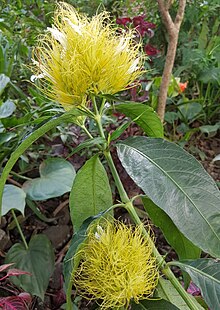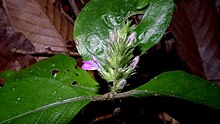Schaueria
Appearance
| Schaueria | |
|---|---|

| |
| The golden plume (Schaueria calycotricha) is widely cultivated as ornamentals | |

| |
| Schaueria hirsuta from Bahia, Brazil | |
| Scientific classification | |
| Kingdom: | Plantae |
| Clade: | Tracheophytes |
| Clade: | Angiosperms |
| Clade: | Eudicots |
| Clade: | Asterids |
| Order: | Lamiales |
| Family: | Acanthaceae |
| Subfamily: | Acanthoideae |
| Tribe: | Justicieae |
| Genus: | Schaueria Nees |
| Type species | |
| Justicia calycotricha Link & Otto
| |
| Species | |
|
See text | |
Schaueria is a genus of flowering plants in the family Acanthaceae. They are endemic to Brazil, from Bahia to Rio Grande do Sul. They are characterized by small elongated white or yellow flowers and narrow to thread-like green or yellow bracts. They are found mainly in rain forests, semi-deciduous mountain forests, and restingas. They are pollinated by bees and hummingbirds.[1]
The genus was established by the German naturalist Christian Gottfried Daniel Nees von Esenbeck in 1838.[2] It is considered monophyletic and includes fourteen species:[1][3]
- Schaueria calycotricha (Link & Otto) Nees
- (syn. Schaueria flavicoma)
- Schaueria capitata Nees
- Schaueria gonystachya (Nees & Mart.) Nees
- Schaueria hirsuta Nees
- Schaueria hirta A.L.A.Côrtes, T.F.Daniel, A.Rapin
- Schaueria humuliflora Nees
- Schaueria litoralis (Vell.) A.L.A.Côrtes
- (syn. Schaueria lophura)
- Schaueria lachynostachya A.L.A.Cortes & A.C.Mota
- Schaueria marginata Nees
- Schaueria malifolia Nees
- Schaueria paranaensis (Rizz.) A.L.A.Côrtes, T.F.Daniel, A.Rapini
- (syn. Justicia paranaensis)
- Schaueria parviflora (Leonard) T.F.Daniel
- Schaueria pyramidalis A.L.A.Côrtes, T.F.Daniel, A.Rapini
- Schaueria thyrsiflora A.L.A.Côrtes, T.F.Daniel, A.Rapini
See also
Wikimedia Commons has media related to Schaueria.
References
- ^ a b Ana Luiza A. Côrtes; Alessandro Rapini & Thomas F. Daniel (2015). "The Tetramerium lineage (Acanthaceae: Justicieae) does not support the Pleistocene Arc hypothesis for South American seasonally dry forests". American Journal of Botany. 102 (6): 992–1007. doi:10.3732/ajb.1400558. PMID 26101423.
- ^ Nees von Esenbeck, C.G.D. (1838). Delectus Seminum in horto botanico Vratislaviensi collectorum a. 1838. Breslau.
- ^ Ana Luiza A. Côrtes; Thomas F. Daniel & Alessandro Rapini (2016). "Taxonomic revision of the genus Schaueria (Acanthaceae)". Plant Systematics and Evolution. 302 (7): 819–851. doi:10.1007/s00606-016-1301-y. S2CID 16617216.
